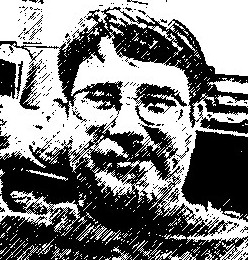I built a standard T-TRAK end cap (180 degree curve) so that I could make a complete oval with both standard and narrow gauge tracks. I hooked everything together...or I tried to at least. I ran into troubles right away.
First I had trouble connecting the narrow gauge track. Aligning two tracks on standard T-TRAK modules is not so bad, get a double crossing track or a piece of double track with 33mm spacing and check it on each end, easy peasy. However, when you add a narrow gauge track at a higher elevation and setback you really have to pay attention to details because everything has to align in all three dimensions. If not, connecting the modules is troublesome when it's not downright impossible. And of course this was the case, I had some modules that would connect straight away with each other in one configuration but went from difficult to impossible with others or in a different configuration.
So, I had to spend some quality time with the template and shims to get everything at the exact height and depth. I had several end pieces that had the narrow gauge track either higher or lower than the others so they had to be carefully aligned, in some instances the end had to be shaved away to lower the track and in other cases it had to be shimmed higher. I also had to adjust a few tracks end to end to make sure the 2mm spacing between modules was consistent through the depth of the modules in every configuration.
I finally got everything straight, and I checked each module by connecting it at each end with every other module. Every module will connect in various configurations (really there are only about twelve possible connections since two of the modules have curved narrow gauge track and straight standard gauge and will only connect to each other in one specific combination) so it should all be good now. And then I ran trains...or attempted to...and found other issues to deal with.
First I had power delivery issues. I have connected the Tamiya connectors, which is what both Kato and Rokuhan uses on their power connector tracks, to my power packs so that I can connect them easily to the tracks. On some of my modules the wiring was less than stellar, so I had to correct them. I checked all three connections on each module, which took a lot of time but was well worth the effort since I know they are all good now.
With the power delivery gremlins banished I was able to put a train on each track and started running them around. It was then I found tracks not connected correctly, or misaligned, within the modules. So I spent a couple of minutes correcting those issues. Then I had a bad hump on the outer track on Dragon Bridge, so it had to be pulled up, the roadbed leveled off, and the track re-laid. Then I had a narrow gauge hopper consistently derailing...but that ended up being a car issue and not a track issue.
Finally I had everything running smoothly, so I ran some trains for a while.
I did eventually put some cars on the standard gauge locos and ran them without difficulties. I also ran multiple engines and consists just because it was fun. I took this little video* and ran some trains all afternoon. Finally I disassembled the modules and put them away.
Now I just need to get the scenery done on them, and then maybe I can get everything evaluated and approved for running in the shows.
*Thanks to recent You Tube policy changes I have removed all videos from my You Tube channel.









































